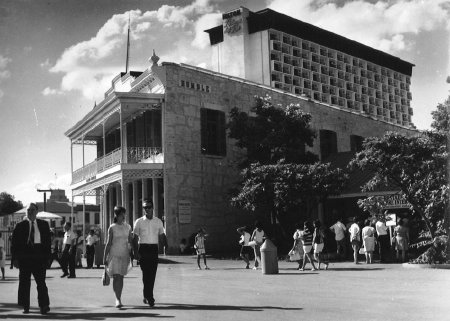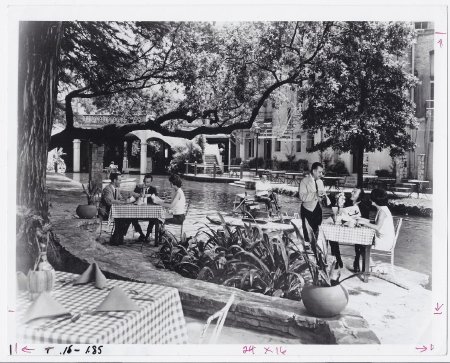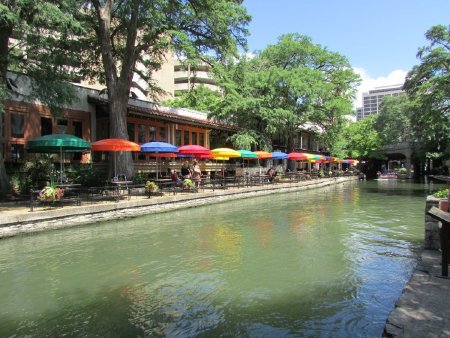HemisFair Floats some Economic Boats
History:
Never was HemisFair's power for economic revitalization more apparent than on the River Walk, which had initially failed to realize the vision of its designer, local architect Robert H.H. Hugman. Shortly after the WPA-created River Walk opened in 1941, visitors were advised to avoid its isolated pathways; the military even went so far as to make the river off limits to its personnel. The owner of Casa Rio, one of
the only restaurants on the river at the time, recalled that business suffered for years.
All of this changed drastically in the 1960s. Several local businessmen had the foresight to pool their resources to attract restaurants, bars, and hotels to the downtown river bend in advance of HemisFair. They founded the River Walk Commission in 1962, capitalizing on the planned extension of the river to the new Convention Center. The contemporary Palacio del Rio Hotel and the renovated St. Mary's University law school, which became La Posada: The Inn on the River (now the Omni La Mansion del Rio), provided the first new riverside accommodations. By 1968, visitors eagerly traveled down the river on colorful barges to eat, shop, and stay at the new hotels. HemisFair goers represented the first trickle in what would become a flood of visitors that now generates billions of dollars in local revenue.
In contrast, local civil rights leader Rev. Claude W. Black, Jr. noted that, "even though [HemisFair] abutted on the (predominantly African-American) East Side, there was no spillover, jobs, or money." Once I-37 was completed immediately behind the fairgrounds, the black community found itself cut off from the core of downtown; the highway creating a physical barrier to economic development that the East Side has struggled for decades to overcome.
All of this changed drastically in the 1960s. Several local businessmen had the foresight to pool their resources to attract restaurants, bars, and hotels to the downtown river bend in advance of HemisFair. They founded the River Walk Commission in 1962, capitalizing on the planned extension of the river to the new Convention Center. The contemporary Palacio del Rio Hotel and the renovated St. Mary's University law school, which became La Posada: The Inn on the River (now the Omni La Mansion del Rio), provided the first new riverside accommodations. By 1968, visitors eagerly traveled down the river on colorful barges to eat, shop, and stay at the new hotels. HemisFair goers represented the first trickle in what would become a flood of visitors that now generates billions of dollars in local revenue.
In contrast, local civil rights leader Rev. Claude W. Black, Jr. noted that, "even though [HemisFair] abutted on the (predominantly African-American) East Side, there was no spillover, jobs, or money." Once I-37 was completed immediately behind the fairgrounds, the black community found itself cut off from the core of downtown; the highway creating a physical barrier to economic development that the East Side has struggled for decades to overcome.
About this Image:
1) The 21-story, 481-room Palacio del Rio Hotel on S. Alamo Street rises above the Humble Oil Pavilion/1891 Schultze Store. The modular hotel rooms were constructed off-site and lifted into place fully furnished so that the building could be completed in 202 days. Photo by Orville Thompson.
2) Diners enjoy Italian cuisine at River Roost, one of the original restaurants open on the river during HemisFair. It later became Michelino's. The Commerce Street Bridge spans the river in the background, while the back of the Clifford Building faces the river on the right. River Walk designer Robert Hugman once officed there.
3) Although the crowds aren't out yet, colorful umbrellas line the water's edge in front of the thriving Casa Rio restaurant. The tables now seat customers all the way back to the Commerce Street Bridge, glimpsed in the background. Photo by Larsen Andrews.
2) Diners enjoy Italian cuisine at River Roost, one of the original restaurants open on the river during HemisFair. It later became Michelino's. The Commerce Street Bridge spans the river in the background, while the back of the Clifford Building faces the river on the right. River Walk designer Robert Hugman once officed there.
3) Although the crowds aren't out yet, colorful umbrellas line the water's edge in front of the thriving Casa Rio restaurant. The tables now seat customers all the way back to the Commerce Street Bridge, glimpsed in the background. Photo by Larsen Andrews.
Credit:
Courtesy of San Antonio Conservation Society Foundation



